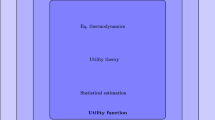Abstract
In this paper we investigate the relation between scalar continuity and representability of monotone preference orders in a sequence space. Scalar continuity is shown to be sufficient for representability of a monotone preference order and easy to verify in concrete examples. Generalizing this result, we show that a condition, which restricts the extent of scalar discontinuity of a monotone preference order, ensures representability. We relate this condition to the well-known order dense property, which is both necessary and sufficient for representability.
Similar content being viewed by others
References
Asheim GB, Mitra T, Tungodden B (2012) Sustainable recursive social welfare functions. Econ Theory 49: 267–292
Basu K, Mitra T (2003) Aggregating infinite utility streams with intergenerational equity: the impossibility of being Paretian. Econometrica 79: 557–1563
Beardon AF, Mehta GB (1994) The utility theorems of Wold, Debreu and Arrow-Hahn. Econometrica 62: 181–186
Beardon AF, Candeal JC, Herden G, Induráin E, Mehta GB (2002) The non-existence of a utility function and the structure of non-representable preference relations. J Math Econ 37(1): 17–38
Bridges DS, Mehta GB (1995) Representations of preference orderings. Springer, Berlin
d’Aspremont C, Gevers L (2002) Social welfare functionals and interpersonal comparability. In: Arrow K, Sen A, Suzumura K (eds) Handbook of social choice and welfare, vol 1. Elsevier, Amsterdam, pp 459–541
Debreu G (1954) Representation of a preference ordering by a numerical function. In: Thrall RM, Coombs CH, Davis RL (eds) Decision processes. Wiley, New York, pp 159–165
Diamond P (1965) The evaluation of infinite utility streams. Econometrica 33: 170–177
Fishburn PC (1970) Utility theory for decision making. Wiley, New York
Hara C, Shinotsuka T, Suzumura K, Xu Y (2008) On the possibility of continuous, Paretian and Egalitarian evaluation of infinite utility streams. Soc Choice Welf 31(2): 179–191
Koopmans TC (1960) Stationary ordinal utility and impatience. Econometrica 28: 287–309
Kreps D (1988) Notes on the theory of choice. Westview Press, Boulder
Lauwers L (2010) Ordering infinite utility streams comes at the cost of a non-Ramsey set. J Math Econ 46: 32–37
Mitra T, Ozbek MK (2010) On representation and weighted utilitarian representation of preference orders on finite utility streams. CAE Working Paper 10-05, Cornell University, Ithaca
Munkres J (1975) Topology. Prentice Hall, London
Peleg B (1970) Utility functions for partially ordered topological spaces. Econometrica 38: 93–96
Svensson LG (1980) Equity among generations. Econometrica 48: 1251–1256
Voorneveld M, Weibull JW (2009) Outer measure and utility. Working Paper Series in Economics and Finance 704, Stockholm School of Economics, Stockholm
Weibull JW (1985) Discounted-value representations of temporal preferences. Math Oper Res 10: 244–250
Wold H (1943) A Synthesis of pure demand analysis, I, II and III. Scand Aktuarietidskr 26:85–118, 220–263, 69–120
Zame WR (2007) Can intergenerational equity be operationalized?. Theor Econ 2: 187–202
Author information
Authors and Affiliations
Corresponding author
Rights and permissions
About this article
Cite this article
Mitra, T., Ozbek, M.K. On representation of monotone preference orders in a sequence space. Soc Choice Welf 41, 473–487 (2013). https://doi.org/10.1007/s00355-012-0693-z
Received:
Accepted:
Published:
Issue Date:
DOI: https://doi.org/10.1007/s00355-012-0693-z




